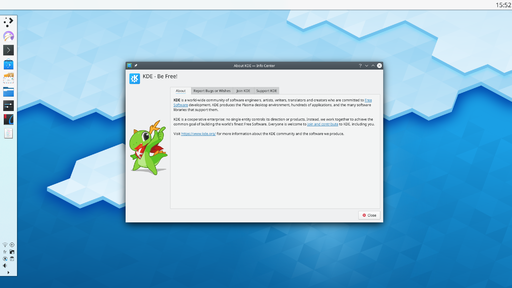Plasma/Plafons
Plafons en l'escriptori Plasma

Un plafó és un contenidor d'estris que es pot ubicar a qualsevol lloc de l'escriptori. Hi pot haver múltiples plafons en el mateix costat. El disseny per omissió és un plafó que s'estén per tota la part inferior de l'escriptori amb els següents estris: menú d'aplicacions, paginador de l'escriptori, gestor de tasques (llista les finestres obertes), safata del sistema, notificador de dispositius i un rellotge. Si utilitzeu un ordinador portàtil, netbook o d'un altre tipus que utilitzi una bateria també hi haurà un estri gestor d'energia. Al final del plafó és un botó de caixa d'eines que es pot activar per accedir a les opcions de configuració.
Configuració
El plafó es pot configurar fent clic a la barra d'eines situada a la dreta del plafó horitzontal o la part inferior del plafó vertical. En aquest moment, el plafó està en el mode de configuració. A la configuració del plafó també es pot accedir a través del menú contextual (fent clic dret) en el plafó.

Els estris al plafó es poden ordenar arrossegant-los en el mode de configuració. Els estris estan alineats a l'esquerra en el plafó horitzontal i la part superior en el plafó vertical.
La caixa d'eines del plafó
- : Permet arrossegar el plafó a qualsevol de les quatre vores de la pantalla.
- (pel plafó horitzontal): Permet ajustar l'alçada del plafó.
- (pel plafó vertical): Permet ajustar l'amplada del plafó.
- : Permet afegir estris al plafó.
- : Permet afegir un espaiador en el plafó donant espai entre els elements.
- El comportament normal d'un espaiador és que utilitza tant espai com sigui possible (mida flexible), però també el podeu configurar a una . Entreu al menú contextual (clic dret) i desactiveu .
El menú «Més paràmetres»
- : Allows the alignment of the panel to be set in three pre-set positions.
-
- : Keeps the panel visible at all times, even when windows are maximised.
- : Hides the panel off screen until the mouse is placed near the screen edge.
- : This allows windows to cover the panel and if maximised, will cover the panel.
- : This allows windows to go below the panel, even when maximised.
- : Makes the panel fit to the screen edges, if it has been resized.
- : Locks the panel and widgets in position. Also hides the toolbox.
- : Removes the current panel and all widgets in it.
Múltiples plafons
It is also possible to have more than one panel on your desktop. This proves useful if you want to have a more flexible layout:

Afegir un plafó
To add a new panel either click on the desktop toolbox button and select or open the context (right click) menu on the desktop and select from the menu.
If more than one kind of Panel is installed, you will be able to select between them to choose what sort of Panel you would prefer. By default, two Panel types are available: , which creates a Panel containing all of the default widgets (launcher, pager, tasks, system tray, clock, etc.), and , which adds an empty Panel without any pre-configured widgets in it.
Bloquejar
The panels and desktop may be locked to prevent changes being made to them. When locked, the toolbox buttons will not be shown on either the desktop or on the panels. To configure a panel, it must be unlocked, otherwise the toolbox and context menu entries to configure or add widgets are unavailable.
Locking can be done by either selecting the entry in the Panel toolbox's menu or in the Panel context (right click) menu. Once locked, the Panels can be unlocked again by right clicking on either a panel or desktop and selecting from the menu that is displayed.
